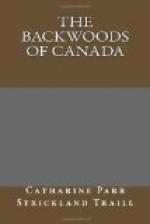The hepatica is the first flower of the Canadian spring: it gladdens us with its tints of azure, pink, and white, early in April, soon after the snows have melted from the earth. The Canadians can it snow-flower, from its coming so soon after the snow disappears. We see its gay tufts of flowers in the open clearings and the deep recesses of the forests; its leaves are also an enduring ornament through the open months of the year; you see them on every grassy mound and mossy root: the shades of blue are very various and delicate, the white anthers forming a lovely contrast with the blue petals.
The wood-cress, or as it is called by some, ginger-cress, is a pretty white cruciform flower; it is highly aromatic in flavour; the root is white and fleshy, having the pungency of horseradish. The leaves are of a sad green, sharply notched, and divided in three lobes; the leaves of some of them are slightly variegated; the plant delights in rich moist vegetable mould, especially on low and slightly swampy ground; the flower-stalk is sometimes naked, sometimes leafed, and is crowned with a loose spike of whitish cruciform flowers.
There is a cress that grows in pretty green tufts at the bottom of the waters in the creeks and small rivulets: it is more delicate and agreeable in flavour than any of the land-cresses; the leaves are of a pale tender green, winged and slender; the plant looks like a green cushion at the bottom of the water. The flowers are yellow, cruciform, and insignificant; it makes a very acceptable salad in the early spring, and at the fall of the year. There are also several species of land-cress, and plants resembling some of the cabbage tribes, that might be used as spring vegetables. There are several species of spinach, one known here by the name of lamb’s quarter, that grows in great profusion about our garden, and in rich soil rises to two feet, and is very luxuriant in its foliage; the leaves are covered with a white rough powder. The top shoots and tender parts of this vegetable are boiled with pork, and, in place of a more delicate pot-herb, is very useful.
Then we have the Indian turnip; this is a very handsome arum, the root of which resembles the capava, I am told, when boiled: the leaves of this arum are handsome, slightly tinged with purple. The spathe is of a lively green, striped with purple: the Indians use the root as a medicine, and also as an esculent; it is often eaten by the settlers as a vegetable, but I never tasted it myself. Pursh calls this species Arum atropurpureum.
I must not pass over one of our greatest ornaments, the strawberry blite, strawberry-bearing spinach, or Indian strawberry, as it is variously named. This singular plant throws out many branches from one stem, these are garnished with handsome leaves, resembling in appearance our long-leaved garden spinach; the finest of this plant is of a bright crimson, pulpy like the strawberry, and containing a number of purple




